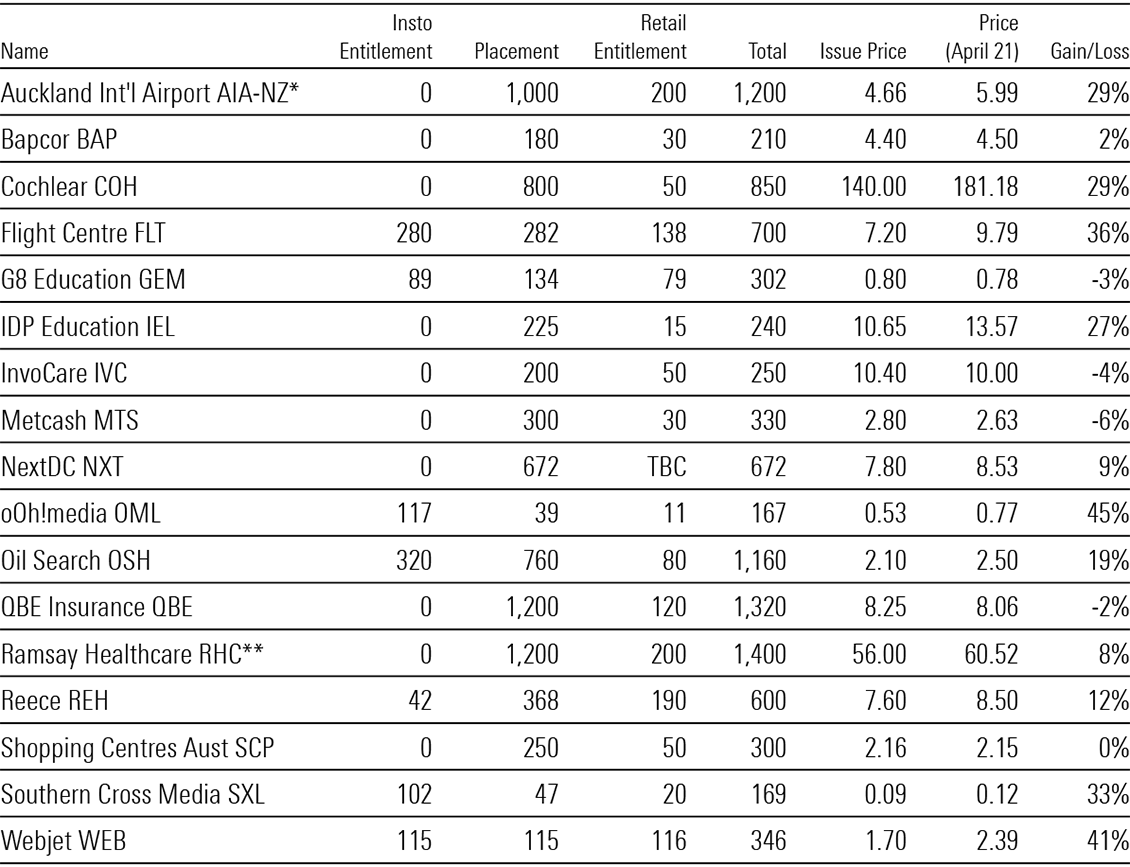Investing basics: what are capital raisings, and should you participate?
Companies are turning to shareholders to help fund them through the pandemic, sometimes leaving them worse off.
Mentioned: Arena REIT (ARF), Cochlear Ltd (COH), Flight Centre Travel Group Ltd (FLT), G8 Education Ltd (GEM), KMD Brands Ltd (KMD), Lucapa Diamond Co Ltd (LOM), National Australia Bank Ltd (NAB), Nextdc Ltd (NXT), Ramsay Health Care Ltd (RHC)
If you've invested in ASX-listed shares, there's a good chance you've been asked to participate in an equity raising this year.
Since the coronavirus pandemic struck global markets in late February, companies have rushed to secure cash in anticipation of an extended journey in uncharted waters.
Big names that come to mind are medical device company Cochlear (COH), Ramsay Health Care (RHC) and National Australian Bank (NAB), which tapped shareholders for $3.5 billion in April. But smaller companies too have launched raisings, including Flight Centre (FLT), data centre operator NextDC (NXT), and retailer Kathmandu (KMD) to alleviate the brunt of a cash flow squeeze, often oftering new shares at vastly discounted prices.
But just because a company comes to market with an equity offer, should investors take them up?
We answer some of your key questions.
Why are companies asking for money?
As the deadly coronavirus spread, authorities cracked down on movement, which stalled the economy and created cash flow uncertainty. Businesses suddenly found themselves without customers and thus without an income stream to pay the bills. As a result, many turned to the equity markets to raise cash to ensure their survival.
Take travel agent chain Flight Centre, for example. Bans on travel were crippling. The previously profitable company, whose share price had been flying high in the years leading up to the crisis, was suddenly forced to close half its global retail shopfronts and layoff thousands. Morningstar equity analyst Brian says this created an unprecedented liquidity squeeze on the group, forcing it to raise $700 million and fast from shareholders.
"The impact has been such that management aims to slash its monthly operating cash cost to $65 million by July 2020, from the prior normal level of $227 million," he says.
Elsewhere, businesses have sought to use the capital raisings to gain a stronger position in the post-COVID19 recovery. Consider G8 Education (GEM). Morningstar equity analyst Gareth James says GEM raised cash in April primarily to reduce the risks created by the coronavirus-related economic slowdown and potentially expand its portfolio.
"By raising a significant amount of capital now, the company materially reduces risks and gains a strong strategic position ahead of the economic recovery and possible industry consolidation," James wrote in a report entitled 'G8 Education raising more war chest than a life raft'.
The table below shows some of the major raisings this year:
Companies going cap in hand for equity capital (in A$m, unless otherwise stated)

*AIA-NZ in $NZ; ** Ramsay Healthcare capital raising announced on April 22 and shares suspended at time of compilation of this table
Source: Morningstar analysts, ASX and company reports
Why raise equity and not debt?
While companies can turn to the debt markets for cash, not all can get it. Others may secure debt financing with a requirement for equity to be raised alongside it. Taking on debt requires the managers to have a reasonable expectation of steady cash flow to make regular interest repayments, plus there is the added risk that investors may feel the company is too highly geared (has too much debt in relation to its equity), which may weigh heavily on the share price.
How is the money raised?
If a company wishes to raise fresh equity, it has two main options: give existing shareholders the right to buy more shares – a rights issue; or offer shares in a placement to a group of people or institution – often combined with a share purchase plan (SPP).
Rights issue
A rights issue offers existing shareholders – whether they be fund managers, pension funds who own a significant chunk of the business, or retail investors who may own a handful of shares - the right to buy further shares.
Shareholders are offered new shares in proportion to ones already owned. For example, West Australian-based diamond producer Lucapa Diamond Company (LOM) recently raised over $5 million under a non-renounceable rights issue – offering eligible shareholders one new share for every five held – to advance exploration.
Rights issues can be accompanied by a separate institutional placement, retail offer and debt facility. For example, Flight Centre launched a $700 million raising in April at $7.20 per share – representing a 27 per cent discount to the last traded price. This was comprised of two parts:
- a $282 million institutional placement
- a $419 million 1 for 1.74 entitlement offer – including $280m institutional entitlement offer and $138 million retail entitlement offer
Placement and share purchase plan (SPP)
Rights issues can get a bit messy for everyone involved and they take a bit of organising. Companies that need to raise new equity fast can do so by making a direct placement, where shares are often discounted to entice shareholders to buy in.
A placing can largely bypass retail investors (which can be controversial), instead allowing the biggest shareholders to snap up more shares in a business. For example, if the board decides it needs to quickly raise $500 million to get through the next year, it can (via a broker) approach individual shareholders to raise capital. This allows them to avoid the administrative task of reaching out to all the shareholders and waiting for them to respond.
A share purchase plan often follows the institutional placement, which may be open to retail investors. For example, Cochlear launched an $800 million institutional placement in March and offered eligible shareholders to participate in a share purchase plan to raise an additional $50 million.
ASIC doubled the maximum amount retail shareholders can apply for in an SPP last year from $15,000 to $30,000. But while investors may apply for $30,000, that doesn't mean they'll receive that value. SPPs can be very popular and if they're oversubscribed, they'll be scaled back, meaning shareholder will only receive a fraction of what they applied for.
Shareholder activist and founder of news website Crikey, Stephen Mayne fears these capital raisings don't reflect the relative proportions of the company owned by institutional and retail shareholders.
"Neither Ramsay Health Care nor Cochlear, even after lifting their SPP caps, adhered to the principle of dividing up the capital raising to reflect the relative proportions of the company owned by institutional and retail shareholders before the capital raising was launched," Mayne wrote in an article for Firstlinks.
"It’s not hard to comprehend. If retail shareholders own 30 per cent of a company, the SPP should represent 30 per cent of the overall capital raising."
Firstlinks managing editor Graham Hand says he's participated in several coronavirus-related SPPs. But on one occasion he received most of his cash back.
"I applied for the maximum of $30,000 and was refunded over $27,000 and at the same time, my holding is being diluted," he says.
What happens if I say no?
Placements can sometimes disadvantage excluded shareholders by diluting their interests in the company's earnings.
Say you own 1000 out of a total of 10,000 issued shares in ABC Limited. In other words, you own 10 per cent of the company and are theoretically entitled to 10 per cent of its earnings. If the company makes $1 million, you make $100,000 - although obviously it may not all be paid out to you as a dividend.
Imagine ABC Ltd decides to raise equity through a placement of 1000 shares at the current market price to a major institution. Suddenly, 11,000 shares are on issue and you still own 1000. Your holding has been diluted to 9.1 per cent of the company.
If the company makes the same $1 million profit, through no fault of your own your share of the profits has fallen from $100,000 to $90,909.
Can it go wrong?
The opportunity to buy more shares should be evaluated on a case-by-case basis, as investors are effectively being asked to take a punt on the company’s future fortunes (and its share price).
Doubling down on shares in a poorly performing company is a risk investors could end up regretting. For example, in 2008, Royal Bank of Scotland raised £12 billion from investors before being rescued by the government - its share price is still yet to recover to 2008 levels.
Conversely, you could be offered shares in the next Apple or Amazon - and kick yourself if you didn’t buy more when you could have. Because the market has been on a tear since March, the discounts being offered by companies can be enormous by the time the SPP is closed.
Recent capital raisings have paid off for participating shareholders, with those priced at bigger discounts such as Flight Centre’s entitlement offer delivering immediate returns.
Morningstar analysts provide guidance to shareholders about whether they should participate in an SPP. Here are some examples – FLT, COH, NAB, ARF. See individual stock pages for further details.


